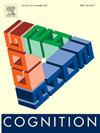Predictable object motion is extrapolated to support visual working memory for surface features
IF 2.8
1区 心理学
Q1 PSYCHOLOGY, EXPERIMENTAL
引用次数: 0
Abstract
Space and time support visual working memory (VWM) by providing incidental reference frames for task-relevant information. While this has been studied with stationary items, natural scenes also contain moving objects, whose positions change over time, often in a predictable manner. We investigated if predictable item motion is leveraged to facilitate VWM for surface features. In a dynamic change-detection task, participants memorised the colours of three disks moving at constant speed in different directions before disappearing. After a retention interval, the disks reappeared (a) at the movement endpoint locations where they had disappeared (b) at positions spatiotemporally congruent with their previous motion (where they would have been had they continued their movement), (c) at positions with a temporal offset (consistent with a change in speed while out of view) or (d) at positions with a spatial offset (consistent with a change in movement direction). Performance decreased with increasing temporal or spatial offsets relative to congruent positions, indicating that the memorised items’ positions were remapped to their anticipated future locations. This updating of positions in spatiotemporal reference frames, however, only occurs if motion extrapolation allows for reliable predictions of where occluded items will reappear. In a task context with unreliable motion patterns, the congruency effect diminished over time and performance instead increased at the movement endpoints. A second experiment confirmed this influence of motion reliability. Thus, predictable motion is extrapolated to update spatiotemporal reference frames in VWM, supporting memory for surface features and thereby contributing to visually guided behavior in dynamic environments.
可预测的物体运动是外推的,以支持表面特征的视觉工作记忆
空间和时间通过为任务相关信息提供附带参考框架来支持视觉工作记忆。虽然这已经研究了固定的物品,但自然场景也包含移动的物体,它们的位置随着时间的推移而变化,通常以可预测的方式。我们研究了是否利用可预测的物体运动来促进表面特征的VWM。在一项动态变化检测任务中,参与者在消失之前记住三个以恒定速度向不同方向移动的磁盘的颜色。经过一段时间的保留,磁盘重新出现(a)在它们消失的运动端点位置;(b)在与它们之前的运动在时空上一致的位置(如果它们继续运动,它们就会在那里);(c)在时间偏移的位置(与视线之外的速度变化一致);或(d)在空间偏移的位置(与运动方向变化一致)。相对于一致的位置,随着时间或空间偏移量的增加,表现会下降,这表明记忆项目的位置被重新映射到它们预期的未来位置。然而,只有当运动外推能够可靠地预测被遮挡的物体将重新出现的位置时,这种时空参考框架中的位置更新才会发生。在运动模式不可靠的任务情境中,一致性效应随着时间的推移而减弱,而在运动终点的表现反而增加。第二个实验证实了运动可靠性的影响。因此,可预测的运动被外推到VWM中更新时空参考框架,支持对表面特征的记忆,从而有助于在动态环境中进行视觉引导行为。
本文章由计算机程序翻译,如有差异,请以英文原文为准。
求助全文
约1分钟内获得全文
求助全文
来源期刊

Cognition
PSYCHOLOGY, EXPERIMENTAL-
CiteScore
6.40
自引率
5.90%
发文量
283
期刊介绍:
Cognition is an international journal that publishes theoretical and experimental papers on the study of the mind. It covers a wide variety of subjects concerning all the different aspects of cognition, ranging from biological and experimental studies to formal analysis. Contributions from the fields of psychology, neuroscience, linguistics, computer science, mathematics, ethology and philosophy are welcome in this journal provided that they have some bearing on the functioning of the mind. In addition, the journal serves as a forum for discussion of social and political aspects of cognitive science.
 求助内容:
求助内容: 应助结果提醒方式:
应助结果提醒方式:


